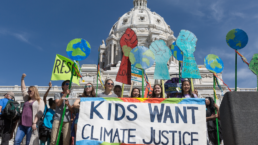Some 107 million Americans will experience heat index temperatures above 125 degrees F by 2053, according to a new report.
By Naveena Sadasivam, Grist
This story was originally published by Grist. You can subscribe to its weekly newsletter here.
In 30 years, counties along the Texas-Mexico border will experience temperatures above 100 degrees Fahrenheit for more than a third of the year. In St. Louis County, Missouri, the heat index — how hot the combination of temperature and humidity make it feel outside — is expected to exceed 108 degrees for three weeks every year, up from just seven days today. And in Monroe, Florida, residents will face temperatures that feel like 100 degrees or more for 49 consecutive days by midcentury.

Those are just some of the startling findings of a new model developed by the nonprofit research group First Street Foundation that examines how climate change will exacerbate heat extremes across the United States in the coming decades. According to the model, roughly 8 million Americans currently live in parts of the country that experience heat index temperatures above 125 degrees F at least one day a year, a threshold the National Weather Service considers “Extreme Danger.” The group’s peer-reviewed model projects that that figure will increase 13-fold to about 107 million in 30 years. The increases in temperature are expected to be concentrated in the middle of the country, in a region the nonprofit has named the “Extreme Heat Belt” — an area running from Texas and Louisiana up to Illinois, Indiana, and Iowa.
“We need to be prepared for the inevitable, that a quarter of the country will soon fall inside the Extreme Heat Belt with temperatures exceeding 125 degrees F and the results will be dire,” Matthew Eby, founder and CEO of First Street Foundation, said in a press release.
First Street was founded in 2016 to develop ways of analyzing climate risk and to help homeowners better understand the threats their properties face. The organization has similar tools to assess the risk of flooding and wildfire to properties, which have been incorporated by real estate companies such as Redfin and Realtor.com. The group’s peer-reviewed heat risk model assigns each property in the United States a score from one to 10 reflecting its exposure to minimal to extreme heat over the life of a 30-year mortgage.
Aside from dangerous heat blanketing the Midwest and parts of the South, the model found that “virtually the entire country is subject to increasing perils associated with heat exposure,” the report concludes. The West Coast is most likely to experience increases in the number of consecutive days of high heat, while the Gulf and southeastern Atlantic states are most likely to face the longest duration of days with heat index temperatures above 100 degrees.
Such temperature increases are associated with serious public health risks. For communities that are not used to warmer weather, such as those in the Midwest, temperature increases and prolonged stretches of extreme heat can be dangerous. Hotter days have been tied to heat fatigue, stroke, and death. A 2021 Los Angeles Times series found that about 3,900 people had likely died in California in the past decade due to extreme heat — a figure six times the state’s official count. Low-income communities and communities of color were hit hardest. Access to air conditioning and the amount of paved surfaces and tree cover determined the effect of higher temperatures on people, the investigation found.
First Street also concluded that a lack of cooling infrastructure is set to exacerbate the consequences of higher temperatures. To make matters worse, cooling costs for those who do have air conditioning are also likely to rise. According to the group’s analysis, Texas and California, the largest consumers of energy for cooling purposes, are set to face a 9- and 15-percent increase in cooling costs statewide by 2053, respectively. These increases in cooling needs are also tied to an increase in carbon dioxide emissions. The top five states with the most cooling-related carbon emissions are Texas, Florida, Ohio, California, and Missouri. The report warned that increasing cooling needs in these states could jeopardize their ability to meet various climate and emission reduction goals.
The report comes amid a summer of record-breaking heat across the country. Last month was among the hottest Julys ever recorded. The scorching temperatures have strained electric grids in Texas, the West and the Midwest. With volatile gas prices, coal plants shuttering, declining hydropower, and extreme heat, the U.S. electric grid has struggled to meet demand. First Street’s new report signals there’s not much relief in sight.
Recent Posts
Politicians Are Betraying Gen Z On Climate
July 10, 2025
Take Action Now While Gen-Zers thrift, knit, crochet, and find other ways to reduce our footprints, Trump and the GOP are greenlighting more climate…
Trump’s Deportation Threat Against Zohran Mamdani Is Shameful
July 10, 2025
Take Action Now In only half a year of Donald Trump’s presidency, he and his allies have turned deportation into an explicitly political threat…
Teachers Union Votes To Cut Ties To The Anti-Defamation League
July 10, 2025
Take Action Now In a momentous vote, the National Education Association voted to cut all ties with the Anti-Defamation League. The reason? “Despite…
2025 War Abolisher Awards Go To Albanese, Nader, Waters
July 9, 2025
Take Action Now The purpose of the awards is to honor and encourage support for those working to abolish the institution of war itself.By World…




